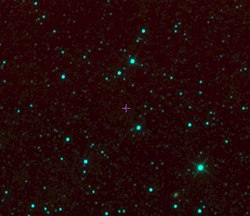| Observation data Epoch J2000.0 Equinox J2000.0 ( ICRS) | |
|---|---|
| Constellation | Scorpius |
| Right ascension | 16h 04m 10.1267s [1] |
| Declination | −22° 34′ 45.5503″ [1] |
| Characteristics | |
| Evolutionary stage | M [2] |
| Astrometry | |
| Proper motion (μ) |
RA: -11.544
[1]
mas/
yr Dec.: -24.892 [1] mas/ yr |
| Parallax (π) | 7.3908 ± 0.1944 mas [1] |
| Distance | 440 ± 10
ly (135 ± 4 pc) |
| Details | |
| Mass | 0.161±0.028 [2] [3] M☉ |
| Radius | 0.631±0.042 [3] R☉ |
| Luminosity (bolometric) | 0.0273±0.0020 [2] L☉ |
| Temperature | 2960±75 [2] K |
| Rotation | 1.63 days [4] |
| Age | 10 [5] Myr |
| Other designations | |
| Database references | |
| SIMBAD | data |
EPIC 204376071 is an M-type star in the constellation of Scorpius. Parallax measurements by the Gaia space observatory put the star at a distance of about 440 light-years (130 parsecs) from Earth. [2] [3] [5] It is likely a member of the Upper Sco association, and is young enough that it has not yet become a main-sequence star. [2]
Unusual light fluctuations of the star, including up to an 80% dimming in brightness (i.e., "single 80% deep occultation of 1-day duration"), were observed by astronomers. [3] [5] The unusual dimming was not only extremely deep, but also substantially asymmetric, with an egress about twice as long as the ingress. [4] Nonetheless, such an unusual dimming for EPIC 204376071 is much greater than the 22% dimming observed for Tabby's star. [6] [7] Several explanations have been presented to explain the unusual dimming of the EPIC 204376071 star: one, orbiting dust or small particles; or two, a "transient accretion event of dusty material near the corotation radius of the star". [3] The unusual lightcurve of the star is similar to the lightcurve of a candidate exoplanet, KIC 10403228 b, which may have been caused by a "tilted ring system" orbiting the planet. In the case of EPIC 204376071, an orbiting brown dwarf or large planet, with a ring system, could cause a similar lightcurve, according to the researchers. [5]

See also
References
- ^ a b c d e f Staff (2019). "EPIC 204376071 -- Star in Association". SIMBAD. Retrieved 6 March 2019.
- ^ a b c d e f Rappaport, S.; et al. (22 February 2019). "Deep Long Asymmetric Occultation in EPIC 204376071" (PDF). Monthly Notices of the Royal Astronomical Society. 485 (2): 2681–2693. arXiv: 1902.08152. Bibcode: 2019MNRAS.485.2681R. doi: 10.1093/mnras/stz537. S2CID 119470865. Retrieved 6 March 2019.
- ^ a b c d e Rappaport, S.; et al. (22 February 2019). "Deep Long Asymmetric Occultation in EPIC 204376071". Monthly Notices of the Royal Astronomical Society. 485 (2): 2681–2693. arXiv: 1902.08152. Bibcode: 2019MNRAS.485.2681R. doi: 10.1093/mnras/stz537. S2CID 119470865.
- ^ a b Nowakowski, Tomasz (5 March 2019). "Astronomers detect deep, long asymmetric occultation in a newly found low-mass star". Phys.org. Retrieved 6 March 2019.
- ^ a b c d Starr, Michelle (6 March 2019). "Astronomers Have Discovered Another Mysterious Dimming Star, And It's Even More Epic". ScienceAlert.com. Retrieved 6 March 2019.
- ^ Carpineti, Alfredo (6 March 2019). "We've Just Found Another Mysteriously Dimming Star In The Galaxy". IFLScience.com. Retrieved 6 March 2019.
- ^ Valdez, Rubi (8 March 2019). "Another Dimming EPIC Star Is Likely An Alien Planet, Astronomers Say". Tech Times. Retrieved 8 March 2019.
External links
- EPIC Catalog at MAST
- Video (00:13) – EPIC 204376071 on YouTube, up to 80% dimming.



